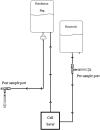The Impact of Three Different Wash Solutions on Autotransfusion Products
- PMID: 29921990
- PMCID: PMC6002646
The Impact of Three Different Wash Solutions on Autotransfusion Products
Abstract
Many blood conservation techniques and strategies have been implemented to aid in decreasing the use of allogenic blood utilization during pediatric cardiothoracic surgery. Use of techniques, such as acute normovolemic hemodilution, retrograde autologous prime, venous autologous prime, and autotransfuion, may lead to a decrease in the need for allogenic blood products. Autotransfusion has become a standard of care for all cardiothoracic surgical procedures requiring cardiopulmonary bypass (CPB). Although widely used, there is still debate over which wash solution will produce the most physiologically normal autotransfusion product. Pediatric patients can be at a higher risk for electrolyte imbalance intraoperatively and postoperatively. In an attempt to minimize this, we sought out to evaluate three different wash solutions and how they would affect the final autotransfusion product. This comparison consisted of three wash solutions; .9% sodium chloride, Normosol-R™, and Plasma-Lyte A. Based on the evaluation of all wash solutions, Plasma-Lyte A produced the most physiological normal final autotransfusion product in regards to electrolytes.
Keywords: autotransfusion product; blood loss; cardiopulmonary bypass; cell saver; electrolyte imbalance; pediatrics.
Figures

Similar articles
-
Isolyte S, a physiologic multielectrolyte solution, is preferable to normal saline to wash cell saver salvaged blood: conclusions from a prospective, randomized study in a canine model.Crit Care Med. 1997 Dec;25(12):2031-8. doi: 10.1097/00003246-199712000-00021. Crit Care Med. 1997. PMID: 9403754
-
Autotransfusion management during and after cardiopulmonary bypass alters fibrin degradation and transfusion requirements.J Extra Corpor Technol. 2007 Jun;39(2):66-70. J Extra Corpor Technol. 2007. PMID: 17672185 Free PMC article. Clinical Trial.
-
Retrograde autologous priming in cardiopulmonary bypass in adult patients: effects on blood transfusion and hemodilution.Rev Bras Cir Cardiovasc. 2011 Oct-Dec;26(4):609-16. doi: 10.5935/1678-9741.20110052. Rev Bras Cir Cardiovasc. 2011. PMID: 22358277 Clinical Trial.
-
Intraoperative hemodilution and autologous platelet rich plasma collection: two techniques for collecting fresh autologous blood.Transfus Sci. 1995 Mar;16(1):33-44. doi: 10.1016/0955-3886(94)00058-r. Transfus Sci. 1995. PMID: 10172465 Review.
-
Management of intraoperative fluid balance and blood conservation techniques in adult cardiac surgery.Heart Surg Forum. 2011 Feb;14(1):E28-39. doi: 10.1532/HSF98.2010111. Heart Surg Forum. 2011. PMID: 21345774 Review.
Cited by
-
Intraoperative Cell Saving: Is the Solution the Actual Problem?J Extra Corpor Technol. 2021 Mar;53(1):62-67. doi: 10.1182/ject-2000047. J Extra Corpor Technol. 2021. PMID: 33814608 Free PMC article.
-
In Vitro and In Vivo Comparison of Hemoglobin and Electrolytes Following the Collection of Cell Saver Blood Washed with Either Normal Saline or Plasma-Lyte A.J Extra Corpor Technol. 2021 Sep;53(3):214-219. doi: 10.1182/ject-2100018. J Extra Corpor Technol. 2021. PMID: 34658415 Free PMC article.
-
Bloodless Arterial Switch Operation in a 2.7-kg Jehovah's Witness Patient.J Extra Corpor Technol. 2020 Jun;52(2):142-145. doi: 10.1182/ject-2000003. J Extra Corpor Technol. 2020. PMID: 32669741 Free PMC article.
References
-
- Guzzetta N, Williams G. Current use of factor concentrates in pediatric anesthesia. Paediatr Anesth. 2017;27:678–87. - PubMed
-
- Ferraris VA, Ferraris SP, Saha SP, et al. . Perioperative blood transfusion and blood conservation in cardiac surgery: The Society of Thoracic Surgeons and The Society of Cardiovascular Anesthesiologists clinical practice guideline. Ann Thorac Surg. 2007;83(5 Suppl):S27–86. - PubMed
-
- Ferraris V, Brown J, Despotis G, et al. . 2011 update to the Society of Thoracic Surgeons and the Society of Cardiovascular Anesthesiologists blood conservation clinical practice guidelines. Ann Thorac Surg. 2011;91:944–82. - PubMed
-
- Huber D, Witt L, Sümpelmann R, et al. . Comparison of bicarbonate-buffered fluid and isotonic saline solution as cell saver washing fluids for packed red blood cells. Paediatr Anesth. 2013;23:1021–6. - PubMed
-
- Halprem N, Alicea M, Seabrook B, et al. . Cell saver autologous transfusion: Metabolic consequences of washing blood with normal saline. J Trauma. 1996;41:407–15. - PubMed
Publication types
MeSH terms
Substances
LinkOut - more resources
Full Text Sources
